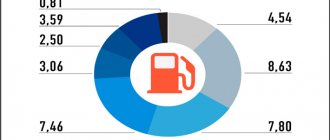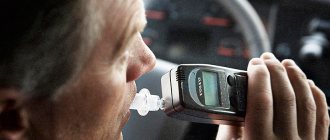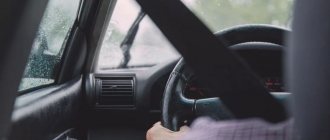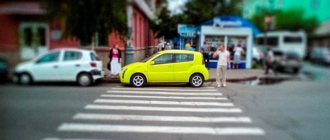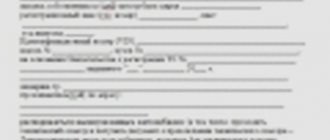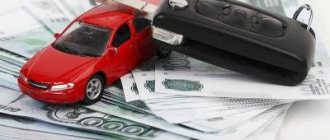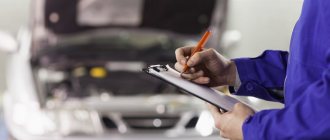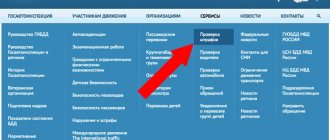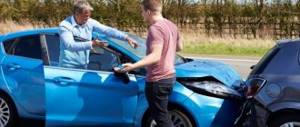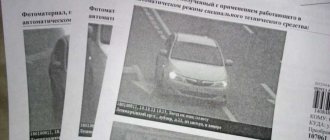What can and cannot be done immediately after an accident in 2021?
So, the first actions in the event of a traffic accident are quite clearly regulated, although they contain some unexpected requirements (you will soon learn about them):
- first of all, paragraph 2.5 of the traffic rules requires you to stop, turn on the hazard lights and put up an emergency sign,
- then it depends on the situation - if there are no victims, you need to decide: either call the traffic police, or draw up a European protocol, or leave altogether, if a number of conditions are met,
- if damage is caused to more than just property, then there is only one option left - call the police,
- Then you will be told to either come to the nearest traffic police department or post for registration, or the employees will come themselves.
There are a number of other conditions if there are victims of an accident, as well as individual requirements listed in paragraphs 2.5-2.6.1 of the Rules. We strongly recommend that you study them carefully, even for repetition.
In order to be able to fill out a European protocol without calling the traffic police, there are separate conditions listed in Article 11.1 of the Law on Compulsory Motor Liability Insurance. But pay attention to paragraph 2.6.1 of the traffic rules. It states that you have the right not to file an accident after an accident, but not at all on the condition that you have no claims against each other, but also if the same conditions for drawing up a European protocol are met: no disagreements, damage was caused only to property, There are only two people involved in the accident, and both have valid insurance policies.
Below we will touch on this subtlety of legislation more than once. In the meantime, let's talk about individual actions - what can and cannot be done immediately after an accident.
Don't stop if it's dangerous
There is some contradiction here within the traffic rules:
- on the one hand, paragraph 2.5 directly obliges you to stop immediately after a collision in an accident,
- on the other hand, there are other points prohibiting stopping - for example, on the highway; But according to the definition of this term, a stop after an accident does not apply to a forced stop.
Of course, you are unlikely to be fined by the traffic police for stopping traffic in violation of the Rules due to an accident due to such a legal conflict. However, in our case we are talking about creating a danger to traffic. For example, if you are involved in an accident on the Moscow Ring Road with dense high-speed traffic, then compliance with traffic rules can lead to another or even a massive accident.
But is it possible to ignore the requirement to stop immediately? In fact, the Administrative Code has Article 2.7, which prohibits punishing drivers, in particular if the offense was committed in order to prevent a greater danger than the violation created. But provided that the consequences of the prevented danger were commensurately less than those caused by the violation. And in this case, this article should work. But whether you will be able to appeal to her in practice is another question. You can safely predict the probability of successfully avoiding punishment as 50/50.
On the other hand, paragraph 2.6.1 of the Rules requires you to clear the roadway if you create an obstacle for other cars, having previously photographed the circumstances of the incident and everything that is related to the case (damaged cars, road signs and markings, general appearance, fragments and so on).
Thus, traffic rules prohibit ignoring the requirement of paragraph 2.5 to stop. But you can do everything quickly to get cars off the road and prevent more collisions with your damaged cars. In the end, it is not your fault that other drivers do not comply with paragraph 10.1 of the Rules.
Place another object instead of an emergency sign
It is rational, in order to warn other drivers about a parked damaged car, in the absence of a warning triangle, to display any other object: a canister, a bottle of water, whatever. But, unfortunately, it is illegal.
Clause 2.5 clearly states that you are required to put up an emergency sign, and clause 7.7 of the List of Faults obliges you to always carry it with you.
For this violation, a fine of 1,000 rubles is provided under Part 1 of Article 12.27 of the Code of Administrative Offenses of the Russian Federation.
Remove car
Returning to 2.5-2.6.1 of the traffic rules, please note that this is the responsibility of the participants in the accident. But you can remove the car only after photographing all the circumstances of the accident, and if there are victims, including after calling the traffic police, providing first aid and sending them in a passing car to the hospital, if necessary.
Please note that if your car creates an obstacle on the road, but you have not fulfilled the obligation to remove it after stopping, this may also result in a fine of 1,000 rubles under Part 1 of Article 12.27 of the Administrative Code.
Start a car
And this is no longer prohibited. Of course, you can warm up (or, conversely, cool down) in a running car or simply start it without objective reasons.
However, there is a nuance here too. If the accident occurred in a yard or residential area, then parking with the engine running in such places is prohibited by clause 17.2 of the Rules. True, in this case you are certainly unlikely to be fined.
Is it possible to drive away from the scene of the accident?
This issue is also very controversial. Many motorists know that for leaving the scene of an accident you can lose your license - such a punishment is provided for in Part 2 of Article 12.27 of the Code of Administrative Offenses of the Russian Federation. So, the line between such concealment and excommunication is very thin.
The fact is that, according to judicial practice in 2021, deprivation of rights for 1-1.5 years goes against the deliberate goal of fleeing the scene of an accident in order to avoid liability. For example, for victims who are not guilty of an incident, such punishment is rarely used.
However, even if you decide to go, for example, to a nearby store for some water or cigarettes and then immediately return to the scene of the incident, we strongly do not recommend doing this. It is also extremely undesirable to go somewhere on foot, even leaving your car where you are (for example, going home to eat while waiting for the traffic police inspectors to arrive).
At the same time, if you simply decided to remove the car from the road, even contrary to the requirements of the traffic rules (you did not photograph the circumstances of the accident before or your car did not create interference), then in this case the article with deprivation of rights should also not apply, since you did not left the scene of the accident. Here only part 1 of the same article should be legally applied with a fine of 1 thousand rubles.
Drink
The use of alcoholic beverages and drugs is strictly and expressly prohibited by the Rules during the period immediately after an accident and before the arrival of traffic police officers (or before your arrival at the department for registration). This is dictated by paragraph 2.7 of the traffic rules.
But in practice, there were cases when an incident was registered, for example, by filling out a European protocol during the day, but in the evening of the same day, traffic police officers came to the participant and examined him for intoxication, and then deprived him of his rights. These are rare and exceptional cases, and also illegal, of course. However, they exist in 2021.
Put another driver behind the wheel
Is it possible to substitute another driver in your place if, for example, you do not have a driving license, are not included in the MTPL insurance, are drunk, or for other reasons? According to the law, of course, the causer of such damage must, of course, be held accountable for damage caused in civil and administrative (and sometimes criminal) fields.
However, if the second participant is not against this situation, there are no witnesses who are willing to confirm that another person was driving during the accident, then in fact nothing prevents a dummy from taking the blame. The traffic police have no way of knowing who was actually driving the car at the time of the collision.
Take the victim to the hospital
Let's return to the above-mentioned main three points of traffic rules - more precisely, to one of them. In our case, 2.6 not only allows, but also obliges us to take victims to a medical facility, but under certain conditions. In descending order of priority, you must complete the following steps:
- call an ambulance immediately after the accident, as soon as you know about the harm to people’s health and the need for medical assistance,
- if necessary, you need to first of all not take the victim to the hospital in your car, but send him on a passing one,
- and only if it is impossible to fulfill point 2 (for example, you are standing on an empty road), then you are obliged to take the injured person in your own car, but then be sure to return to the scene of the accident.
Well, in all 3 cases, before this you must fulfill the requirements of paragraph 2.5 of the Rules: stop (otherwise, how will you find out if there are victims), turn on the emergency lights and put up an emergency sign, call the police and report the incident.
Actions of a motorist after an accident
According to Art. 12 of the Federal Law “On Compulsory Motor Liability Insurance” dated April 25, 2002 No. 40-FZ and the Compulsory Motor Liability Insurance Rules, the injured motorist must contact the insurer of the culprit of the road accident no later than 15 working days from the date of the accident to submit a written application for insurance payments.
The following documents must be attached to the application:
- certificate of accident;
- passport of a citizen of the Russian Federation;
- driver license;
- OSAGO policy;
- notification of an accident;
- vehicle registration certificate;
- vehicle registration certificate;
- bank details of the account to which the insurance compensation must be transferred.
If drivers file a traffic incident using a simplified procedure without involving traffic police officers, then the completed European Protocol must be delivered to their insurance company within 5 working days. A similar package of documents is attached to the European Protocol, with the exception of a certificate of an accident, which is issued only by a traffic police inspector.
The insurer is obliged to conduct an inspection or organize an independent examination of the damaged car within 5 working days from the date of receipt of the application for insurance payments. The vehicle is inspected by an insurance company appraiser. Based on the inspection, the amount of insurance is calculated.
When a dispute arises between the car owner and the insurer about the amount of compensation for damage caused, the insurance company organizes an independent examination. The motorist is given a referral to conduct an expert study. The injured driver organizes an independent examination within 5 working days.
Is it possible to separate and leave the scene of an accident without consequences?
As we already wrote above, clause 2.6.1 (paragraph 2) allows you to leave the scene of the incident and not report it anywhere or to anyone. But only if the following conditions are met:
- as a result of an accident, damage was caused only to cars, and there are 2 of them - no more and no less,
- the circumstances of the incident do not give rise to controversy,
- both have valid MTPL policies.
In general, 2.6.1 was probably written in such a way that participants fill out a Euro protocol before driving away after an accident. However, literally this point was described only in the form of criteria for drawing up a European protocol as conditions for leaving the scene of an incident - that is, it is not necessary to fill out a notice.
If I am a victim and just don’t want to wait, is it possible to leave the accident?
Of course, it is not for nothing that one of the criteria was mentioned above - the absence of disagreements regarding the circumstances of the accident. If the second participant wants to call the police, then you should not leave either. Moreover, now you think that it was not your fault that you got into an accident. However, inspectors may decide otherwise. And then it is no longer possible to avoid deprivation of rights for a long period.
If there are victims
In all cases, if after an accident there is harm to people’s health, you should call the traffic police and follow their instructions. Clause 2.6 precisely contains the requirements in the presence of victims, and it clearly states this obligation.
It also happens that you got into an accident and decided to separate from the second participant, deciding that he was at fault, and you have no claims against him, or if he compensated you for the harm caused on the spot. But he returned to the scene and called the police. As a result, the original culprit presented the circumstances in a light favorable to himself, and... you already become the culprit. And, since you left the scene of the accident, you will face deprivation of your license. The best “cure” for such auto frame-ups is a receipt indicating all the data: the date and time of the accident, damage, the culprit, fulfillment of the conditions for drawing up a European protocol, the absence of claims from each of the parties and compensation for damage by one of the participants to the other, indicating the amount.
What does the cost depend on?
The cost of repairs depends on the damage sustained as a result of the accident. To determine the amount of damage, an assessment is carried out in one of the following ways:
- On one's own. The driver can visually assess the damage without calling the traffic police. 50,000 rubles can be received from the insurance company . It is important to take into account that errors should not be made in the documents, which could lead to refusal of payment.
- Experts. According to the latest changes in the rules on compulsory motor liability insurance, damage assessment must be carried out by an expert appointed by the insurer. In case of litigation, an independent examination is carried out in third-party organizations.
Drivers rarely use the European protocol due to the complexity of paperwork. The slightest mistakes will lead to the insurer refusing to issue a referral for car repairs.
You will have to prove your right in court, but this method has significant disadvantages:
- lengthy proceedings, including drawing up a statement of claim, collecting evidence, conducting an examination, etc. Litigation can last several months;
- it is necessary to pay the costs of filing a claim and conducting an examination;
- the proceedings do not always end in favor of the plaintiff or the insurer is obliged to pay an amount less than the actual damage to the car.
Considering the shortcomings of the European Protocol, drivers prefer the classic option, which consists of registering the scene of the incident by traffic police.
In this case, the damage assessment is carried out by professional experts working with the insurance company.
And to find out the cost of repairs, you will need to submit an application within 5 days from the date of the accident and provide the necessary documents. They include an inspection report of the car at the scene of the accident.
This document contains important information:
- information about the inspection of the damaged vehicle and information about the owner;
- grounds for conducting an independent examination (road accident in the form of a collision of two or more cars);
- a detailed description of the scene of the incident;
- information about the damage received, which is visualized at the time of inspection (this includes dents, chips, scratches);
- information about possible hidden damage to the vehicle (it must be indicated in which part of the vehicle internal damage may occur);
- data on external factors that made it possible to determine the cause of the accident and the guilty party;
- signatures of the parties agreeing with the specified information and the full name of the employee who prepared the document.
The inspection report must be accompanied by photographs from the scene of the incident, which visualize:
- license plates of the vehicles involved in the accident;
- general damage plan;
- Close-up of each damage.
Taking into account the specifics of the work of insurance companies and the rules for receiving payments under compulsory motor liability insurance, the cost of repairs is influenced by the following factors:
- the number and type of damage received;
- no errors in documents;
- completeness of information in the inspection report;
- quality of information from the scene of an accident.
Much depends on the integrity of the insurer. Reluctance to make payments leads to lengthy litigation and a reduction in the amount of compensation.
The insurer may charge fees for bank transfers, payment processing and other imaginary services.
The policyholder should know that according to the rules of compulsory motor liability insurance, the insurance company is obliged to fully reimburse all costs associated with restoring the car after an accident. You don't need to pay anything out of pocket!
What happens if you file an accident report after an accident?
If for one reason or another you were unable to register the accident immediately (and this can happen for completely different reasons), then nothing prohibits, if all participants agree, to register the accident later: after a few hours, the next day, after a few days, a week, etc. etc. The main thing is not to exceed this deadline, so that the insurance company does not refuse for the reason that the damage was clearly received earlier than the date of the incident.
But it won’t be possible to register an accident retroactively if you call the traffic police. In the case of the European protocol, nothing prevents such fraud from being carried out.
Important note!
- This article describes the basic principles of how legislation works. Meanwhile, in judicial practice everything depends on specific circumstances.
- In 96% of all cases there are subtleties that can affect the outcome of the entire case.
- Therefore, we recommend entrusting the matter to professionals who will study your business and select the right winning strategy.
The TonkostiDTP website employs professional road accident lawyers with experience in all major types of disputes (MTPL, guilt, administrative penalties).
Ask a lawyer
or get a free consultation by calling the hotline: 8.
Let's sum it up
In conclusion, I would like to note a few important points. It is strictly forbidden to repair your vehicle until an automotive examination has been carried out and, if difficulties arise, a court order has been issued.
The reason for this is simple - after repair, it is extremely difficult for the transport crew to inspect for any damage that was caused to the car during a traffic accident.
The car owner must know:
- repairs are prohibited until the insurance company has inspected and assessed the vehicle;
- you cannot begin to repair the car until an independent expert assessment has been carried out, with the help of which you can get a real picture of the damage to vehicles after an accident;
- when the person at fault for an accident can have their car repaired - only after an independent examination, but it is necessary to collect all payment documents confirming the fact of the repair work;
- It is possible to repair a car after severe damage only after the legal proceedings to establish the party at fault in the accident are completed.
By hastening with repair work, a car owner whose car is involved in a traffic accident may lose insurance payments and, accordingly, all costs fall entirely on the driver’s shoulders.
Therefore, experts strongly recommend going through all the steps on the way to insurance compensation and only after that starting repair and restoration work on your four-wheeled horse.
Good luck on your journey!
You might be interested in:
How and in what cases can you demand compensation for damages from the culprit of an accident?
Which insurer should I contact for payment?
How long to wait for payment from the insurer after an accident?
How to get compensation if the person responsible for the accident is not insured?
Comments
Who can get insurance in case of an accident?
In 2021, insurance works in such a way that the following can receive compensation for damage caused:
- the victim under compulsory motor liability insurance, if the culprit has a valid insurance policy,
- the culprit if he has Casco insurance.
Of course, the culprit under compulsory motor liability insurance will not be able to receive anything, because this type of insurance provides for the risk of liability after an accident, and does not insure his own property. The exception is mutual guilt. In this case, each participant receives payment in equal shares according to the number of participants (for example, 50% of the amount of compensation if there are two participants), or according to the degree of guilt, if it was established by the court.
Is it possible to recover from the culprit and what?
The perpetrator of the harm directly compensates the damage to the victim in the following cases:
- the culprit did not have compulsory motor liability insurance (in this case, it does not matter whether the victim has it) - if the culprit was simply not included in the current insurance, then there will be a payment (and then there will be recourse),
- if we are talking about the difference between the actual amount of damage to the car and the insurance calculation taking into account wear and tear - alas, the Constitutional Court recently ruled that it is legal to recover the difference in wear and tear,
- when we are talking about moral damage when causing damage to the health or death of victims (MTPL does not compensate for moral damage).
Is it possible to drive a car after an accident?
And again we return to the traffic rules - more precisely, now to one of its applications - the List of faults under which the car cannot be operated. You can simply read all the points and find out whether, given your particular injuries after an accident, you can drive a car.
But there is good news here - paragraph 2.3.1 of the traffic rules indicates that you can drive from the scene of the accident to the parking lot or to the repair site with defects that arose as a result of this accident. But there are exceptions here: if after an accident the headlights do not work (at least one headlight is not on or you are driving without it) or the rear lights at night, the brake or steering system, then you cannot drive in any way. Tow truck only!
Thus, there are 2 options for moving:
- immediately after an accident, in order to get home or to a car service center, you have the right in case of any malfunctions, except if you are driving without headlights, tail lights in the dark, as well as with non-working brakes or steering,
- You can then drive if the damage after the accident is not listed in the List of Faults.
For example, if you have the following consequences after an accident, you can drive a car:
- if the bumper, fender and almost any other body parts are damaged,
- if the airbags are fired (but you can’t drive with non-working seat belts),
- broken glass (only if missing, moving is prohibited).
Otherwise, you may face a fine of 500 rubles under Part 1 of Article 12.5 of the Code of Administrative Offenses of the Russian Federation.
A separate epic is happening with license plates. It is prohibited to travel without them. If you have a missing bumper or a damaged trunk lid, then it is better to attach them approximately in the place where they should be, with the part to which they are attached in place. The main thing is not to drive with a license plate under the windshield or rear window - this may result in deprivation of rights for 1-3 months or a fine of 5,000 rubles under Part 2 of Article 12.2 of the Administrative Code of the Russian Federation.
Is it possible to repair a car?
And this will depend on who you are recognized as a result of an accident: the culprit or the victim, as well as on the method of registering the accident.
If you have become an injured party as a result of an accident and are going to receive insurance compensation for the damage caused, then you cannot repair the car yourself. In this case, there are 2 possible scenarios:
- in any case, you are prohibited from restoring the car after an accident and until an inspection or examination of the damaged vehicle is carried out (clause 11 of article 12 of the Federal Law on Compulsory Motor Liability Insurance),
- and after assessing the car, if you have not yet figured out the form of compensation for damage, you also cannot begin repairs yet; Only after the payment has been made in money can you begin to restore the car, but if you are given a referral for repairs, then the car repair shop will repair the car for you.
Otherwise, there will be a completely legal refusal of insurance compensation under OSAGO on the basis of paragraph 20 of Article 12 of the law.
How long before the culprit is allowed to start repairing the car?
For the culprit, everything is somewhat stricter in terms of possible consequences. Although, most motorists do not fully understand how legislation works in 2021. But this applies only to the European protocol.
Here, as the culprit of the accident, you have 2 main responsibilities, already regulated by Article 11.1 of the above Federal Law:
- not to repair your car for 15 calendar days, except non-working holidays, after an accident and provide it for inspection at the request of your insurance company,
- after the specified 15 days, you have the right to restore the car, but you still have the obligation to show it to the insurer upon his request - even if it has already been repaired.
And the culprit for failure to fulfill one of these duties may face recourse. Clause 1 of Article 14 of the Federal Law gives such an opportunity to an insurance organization. But let us remind you that we are only talking about registering an accident using the European protocol.
When can a car be repaired after an accident?
Most drivers after a traffic accident strive to arrange repairs for their four-wheeled “friend” as quickly as possible. However, this decision is wrong.
First of all, an assessment of the damage received and its cost is communicated to the owner of the vehicle from the insurer where the MTPL policy was purchased. With such a document, the car owner must contact repair shops.
In turn, a specialist at a service station assesses the complexity and amount of work required to return the car to the original condition it was in before the accident.
If the results of the damage assessment and the cost of repair and restoration work coincide, then you can begin restoring the car. But before repairing a car, it is necessary to obtain the consent of the party at fault in the emergency.
In the event that the person at fault for a traffic accident does not agree with the assessment of the insurance company, he must go to court and file a claim to have this case considered. This is the only way one of the participants in the precedent can defend his point of view on the road surface.
Wear calculation
How to evaluate vehicle repairs after an accident? After the car owner contacts the insurance company or an independent expert, specialists will carry out calculations and determine how much the car was damaged as a result of the traffic accident. The purpose of such manipulations is to determine the amount of costs for repair and restoration work.
Expert assessment always causes a lot of dissatisfaction, so the authorities in 2010 developed a regulatory document called “Rules for establishing the amount of costs for materials and parts for the restoration of transport vehicles.”
This regulatory document sets out the rules and procedure for determining the wear and tear of vehicle spare parts. If the car owner carefully studies the document, he will be able to calculate on his own how much money will need to be spent on restoring the car after the incident on the road surface.
Wear and tear of vehicles is a quantitative measure of physical aging under the influence of external or internal factors. Wear occurs during direct use of the vehicle and is characterized by the condition of the vehicle itself and its structural elements.
When assessing wear, experts distinguish the following types:
- moral type;
- physical (natural).
Any spare part of a car is subject to wear in several stages:
- study of rubbing parts;
- the time period when the parts are fully functioning (as a rule, this is 80-90% of the entire period of operation of the vehicle);
- increased wear (accidental wear).
To calculate wear, experts use the following formula: Car body wear as a percentage = 100 * (1 – natural logarithm base – ((4 * body age) / (20 + 4 * warranty period against corrosion processes)).
To calculate tire wear, you can use the following formula: Wear = ((height of the tread pattern - the actual height of this indicator) / (height of the tread pattern - the minimum height of this indicator according to legal regulations)) * 100%.
In addition, wear will increase depending on the service life of the machine:
- 3-5 years – by 15%;
- over 5 years – by 25%.
If we take into account the coefficients that were approved by legislative documents, we can conclude that during the year of operation of the car, its cost will decrease by 5.5%. That is, over 10 years, the depreciation of a vehicle in the domestic automobile industry will be as much as 55%.
Therefore, experts recommend giving preference to more reliable cars, which are Japanese cars.
When calculating the wear and tear of a vehicle and its component parts (when assessing damage caused as a result of a traffic accident), it is necessary to be guided by the standards of Resolution VR No. 361 of May 24, 2010.
But at the same time, it is possible to apply the prescribed provisions in reality only after the availability of documentation, a list of components for which correction factors have not been applied.
Independent examination
Any car owner can legally resort to the help of independent experts in the following cases:
Read more: Contract with the general director of LLC sample 2018
- if you disagree with the examination carried out by the insurance company employees;
- if it is necessary to determine the real value of the car after an accident;
- to assess the damage caused by an accident in order to determine the amount that needs to be paid for restoring the car.
Steps to payment under compulsory motor liability insurance.
Experts from expert companies carry out the entire independent research procedure - from signing an agreement with the customer to handing over the finished result within three to five working days. When the vehicle has received very serious damage that suggests hidden defects, the examination can be carried out within seven working days.
Court cases
A car owner can go to court if he is not satisfied with any results of a car assessment, either from the insurer or the party at fault in the accident. It is the court that can put the finishing touches on determining the amount of insurance payments.
As a rule, when filing a claim, the car owner demands compensation, which can be used to cover:
- repair and restoration work of the car after an accident, assessed as a result of an independent examination;
- costs of paying for the services of an expert firm;
- costs of sending postal notifications to interested parties.
Is it possible or not to sell the car without restoring it?
Now let's complicate the issue. For the victim, everything remains simple here - you can sell the car, and then the right to claim restoration passes to the new owner.
For the culprit, everything is more complicated. Clause 3 of Article 11.1 of the law does not directly speak about the obligation not to sell a car. There are only 3 responsibilities:
- provide the car at the insurer's request,
- do not repair for 15 days,
- do not dispose of residues during this time.
But there is no talk of alienating the car. And yet, it is better not to sell the car within the specified period, because the obligation to provide the car to the insurance company will in this case be unfulfilled. And then the issue of regression may be relevant.
What will be the penalty for violating this law?
There is no fine, no deprivation of rights, or any other administrative punishment for this. But there is, perhaps, something more terrible - the right of the insurance company to recover from you everything that it paid to the victim. This is called a "recourse claim".
If you repair the car within 15 days or otherwise hide damage from an accident and show the car not in the same condition as it was immediately after the accident, then the insurance company has the right to issue a recourse on the amount of compensation to the victim.
Such recourse is provided for in subparagraph “h” of paragraph 1 of Article 14 of the Federal Law on Compulsory Motor Liability Insurance.
It happens like this:
- you repair the car before the expiration of 15 days contrary to the legal requirement,
- the insurer requires you to provide the car for inspection,
- you don’t provide it or show it already repaired,
- The insurance representative will not show you anything right away, but after some time (usually from 2 weeks to six months) you receive a letter at your registration address with a recourse claim and an offer to pay the specified amount within a reasonable time (the period is often also indicated - 10-20 days),
- If you do not comply with the insurance requirement, then the next letter you will receive is a subpoena with a recourse case.
Is it possible to avoid regression?
Hardly ever. It is according to the practice of courts of general jurisdiction, since the right of recourse is expressly stated in the legislation, that the courts satisfy the claims of insurance companies in the vast majority of cases.
But there are exceptions. For example, in one of the courts in Tatarstan, the culprit managed to avoid recourse by motivating the violated right of the insurer by the fact that if the right had not been violated, this would not have affected either the amount or the fact of payment to the victim.
But in that case, we are talking about another violation - failure to notify the insurance company within 5 days, and not a ban on repairs within 15 days. In our case, everything is similar: if you repaired the car before the expiration of the prescribed period of 15 days, then this will not affect anything:
- nor on the very fact of the obligation to compensate the victim,
- nor on the amount, timing or other factors of such compensation.
We examined the issue of avoiding recourse in more detail in the article on judicial recourse with reference to materials from judicial practice.
Will it be possible to withdraw the application and close the case after an accident?
No. Administrative proceedings, unlike criminal ones, do not make it possible to terminate the case by amicable agreement of the parties. This means that if the traffic police, for example, is aware that the culprit has fled from the scene of an accident, then it will not be possible to revoke the protocol against him either at the request of the victim or in any other way.
Another thing is that in practice in 2021, sometimes employees meet the needs of those involved in the accident, and the punishment can be reduced if the victims testify. But not always.
Is it possible to challenge guilt in an accident and appeal the European protocol?
Yes, sure. Here you need to understand the most important thing - traffic police officers never determine the culprits of the incident, only the court does this. The first ones only make decisions. However, in general cases, this document is sufficient to contact the insurance company for payment.
However, if you do not agree that such a decision has been made against you, you can appeal it. This is done in exactly the same way as if you were simply given a fine on the road, or even if it came to you from auto-recording cameras. On the back of the copy of the decision you received (or the ruling, depending on what exactly was written out) there are details for filing a complaint.
If you manage to cancel the decision, then the case must be sent for a new trial, where the second participant will become the culprit.
What is better after an accident, money or repairs?
When choosing between receiving monetary compensation and agreeing to repairs, you should take into account the insurance rules. Many insurers do not provide a choice by issuing a referral to a service station after an assessment.
If it is possible to give preference to one of the two options, you should consider the features of both methods of car restoration.
Car repairs sent by an insurance company have some nuances:
- The policyholder does not have the opportunity to choose a service station. The car will have to be sent to a workshop with which the insurer cooperates. And this is not always convenient in terms of the organization’s distance from home, its reputation and other parameters that the driver usually pays attention to when choosing a service station.
- The policyholder will have to leave the car at the station without controlling the process of restoring the car. And this threatens with poor-quality repairs and missing hidden damage.
- After poor-quality repairs, there is no one to make a claim to correct the defects. The insurance company says to contact a service station. The workshop claims that they did everything for the amount that was transferred from the insurance company.
- Repairs are paid for, taking into account wear and tear of parts; you will have to pay extra at your own expense.
- It takes a lot of time to issue a referral to a workshop and repair a car. The policyholder sometimes has to wait several months. In the best case, the car is running and you can move around on it.
And if the car was badly damaged in an accident and cannot be used without repair, you will have to make do with other means of transportation for several weeks.
Having received the money in hand, the car owner can independently choose a workshop and decide on the need for repairs. In some cases, restoring a car is pointless; it is faster and more profitable to purchase a new vehicle.
Choosing an auto repair shop yourself allows you to save money by choosing an organization where services are provided at low prices.
And in case of poor-quality repairs, there is someone to demand compensation for damage or re-carrying out the work.
But receiving monetary compensation is not always relevant. In some cases, there is not enough money to restore the car, and you have to pay extra from personal funds.
The insurance company is obliged to fully cover all costs associated with repairing the car after an accident.
But the policyholder must decide for himself: to take advantage of the insurance company’s offer or take compensation for further repairs of the car.
It should be borne in mind that insurers are reluctant to agree to pay out money, so you will have to wait a long time for the funds to arrive in your account.
What if you transfer the property so as not to compensate for the damage?
No one will forbid you to re-register your property. However, this will not save you from compensation for damage. The saddest thing that can await you in this case is that the court will recognize the alienation agreement (sale, donation, exchange, and so on - depending on how exactly you got rid of the property) as fictitious and, as a result, void. This can happen if the judge believes that you really wanted to get rid of ownership in order to avoid paying damages to victims of an accident.
In addition, even at the stage of civil court, when filing a claim, the victim can file a petition for a ban on alienation during the trial.
Is it possible to restore a total car and continue driving?
Yes. And any machinations of insurance companies in this case will be illegal. The fact is that if your car is considered a total loss after an accident, this does not mean its actual constructive loss, and insurers know about this, they are simply carefully trying to manipulate clients.
The term “total destruction” is generally purely economic. It means that the cost of repairing a car exceeds the price of the car itself (or is close to it). But in no case does this mean that the car only needs to be disposed of after receiving the “total” payment. This is also confirmed by the Supreme Court in Resolution of the Plenum No. 58 of December 26, 2017 (paragraph 42).
Thus, according to the law, after recognizing the total loss of the car, you have the right:
- restore it,
- register with the traffic police,
- sell or buy,
- issue a new MTPL policy.
However, it is with the last action that problems may arise, according to established practice - insurance companies are very reluctant to sell policies and refuse to conclude a contract on the grounds that the car was recognized as total. This, as we have already indicated, is illegal. But you may have to go to court to restore your legal rights.
Who assesses the cost of car repairs after an accident?
The cost of car repairs is calculated after assessing the damage.
As mentioned earlier, this is done in three ways:
- on one's own;
- insurance company experts;
- independent experts.
Self-assessment of damage is possible for minor damage totaling up to 50,000 thousand .
In this case, the basis for receiving compensation or referral for repairs from the insurance company is the Europrotocol.
The second way to assess damage is to contact experts collaborating with the insurance company. As a rule, the service is free, but has an increased risk of receiving incorrect calculations.
It is not profitable for insurers to pay for expensive repairs, so the amount of damage is often greatly underestimated. The opposite can only be proven in court.
But it is worth writing a statement of claim only if the policyholder is confident that the calculations were made incorrectly, so as not to incur the costs of pursuing a lawsuit.
It can be difficult for drivers to prove that their car has hidden damage. Appraisers miss this point by indicating only visible scratches and dents in the report.
The policyholder needs to personally monitor this process, relying on the vehicle inspection document drawn up after the accident.
If the driver does not agree with the assigned amount, he will need to go to court, which will order an additional examination.
It is more profitable for the driver to contact an independent expert and pay for his services. This will provide up-to-date information about the cost of repairs. But this opportunity is not always provided.
According to the rules of OSAGO, the examination can only be carried out upon the direction of the insurer.
And if the insurance company gives permission to contact a third-party organization, then the driver can send his car to a professional expert.
What if you get into another accident after the first?
How many times can you get into an accident within a certain period of time - for example, a year? Unlimited. The legislation in 2021 does not punish in any way for frequent accidents, even if you are found to be at fault in all of them. That is, there will not be any harsher fines, deprivation of rights, arrest or other measures of responsibility simply for the fact that you got into a second and subsequent accident. Only for the violation that led to the accident.
However, your culpability in accidents and insured events as a result directly affect the cost of compulsory motor liability insurance. The point here is a special coefficient - KBM. Its maximum value can be 2.45. And this means that if you get into, for example, 4 incidents during the year, in each of which you are found guilty, and the victim applies for compensation, then in the next insurance period the cost of the policy will increase for you by a conditional 2.5 times.
